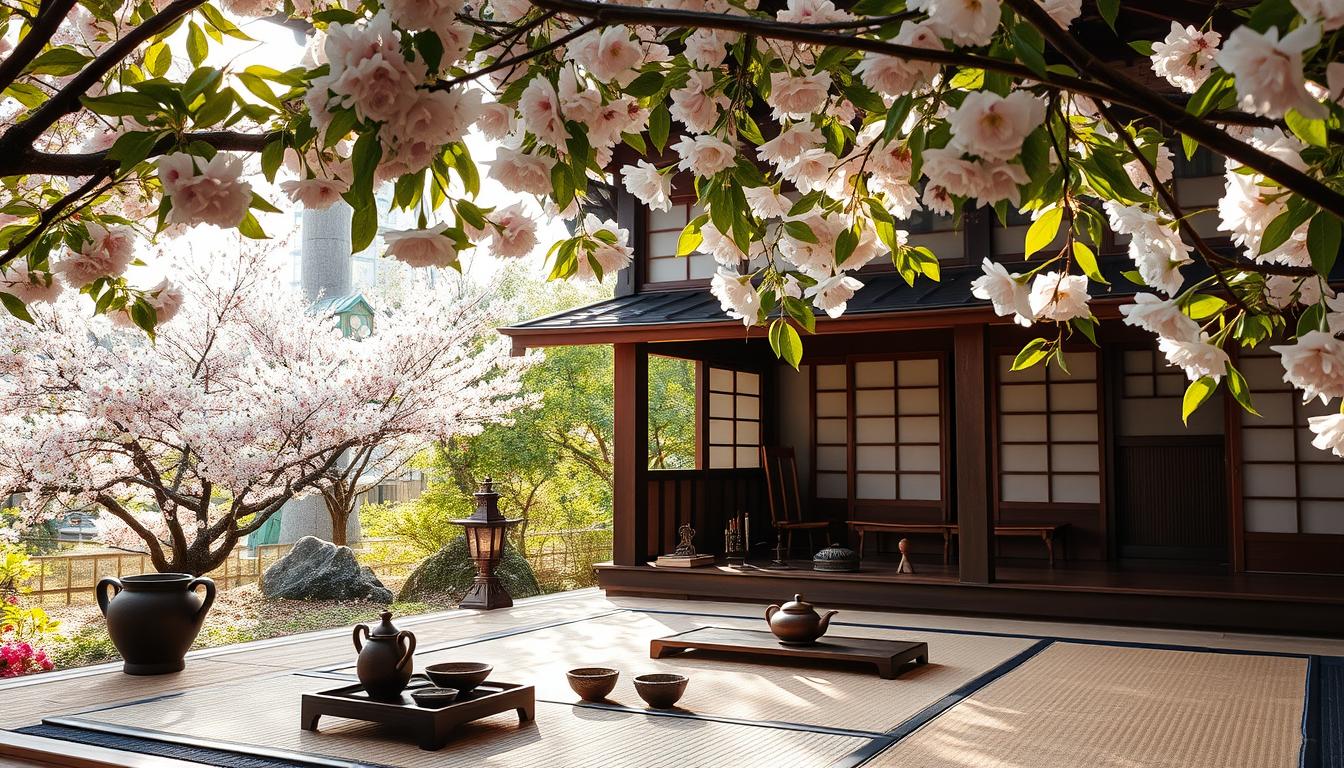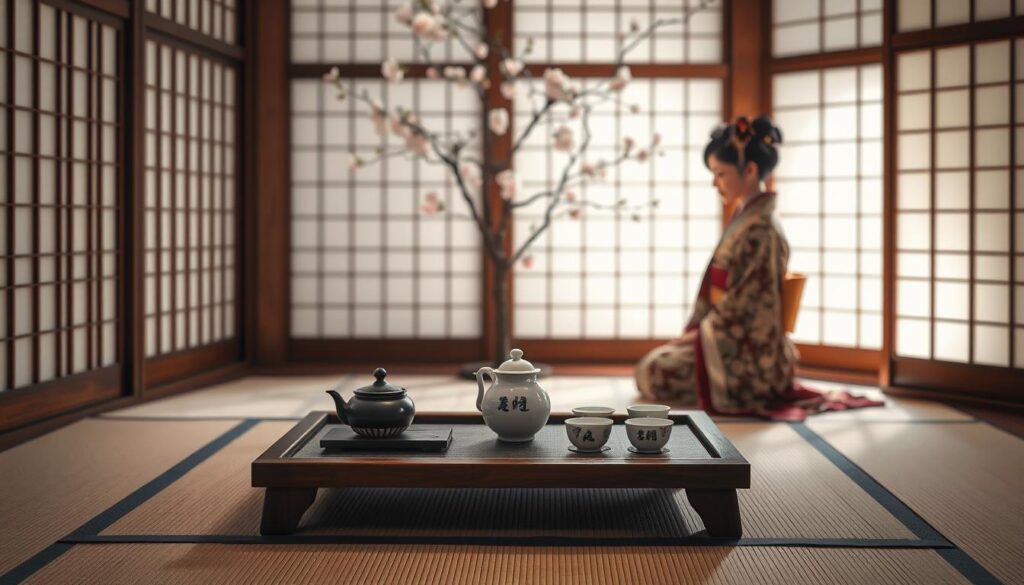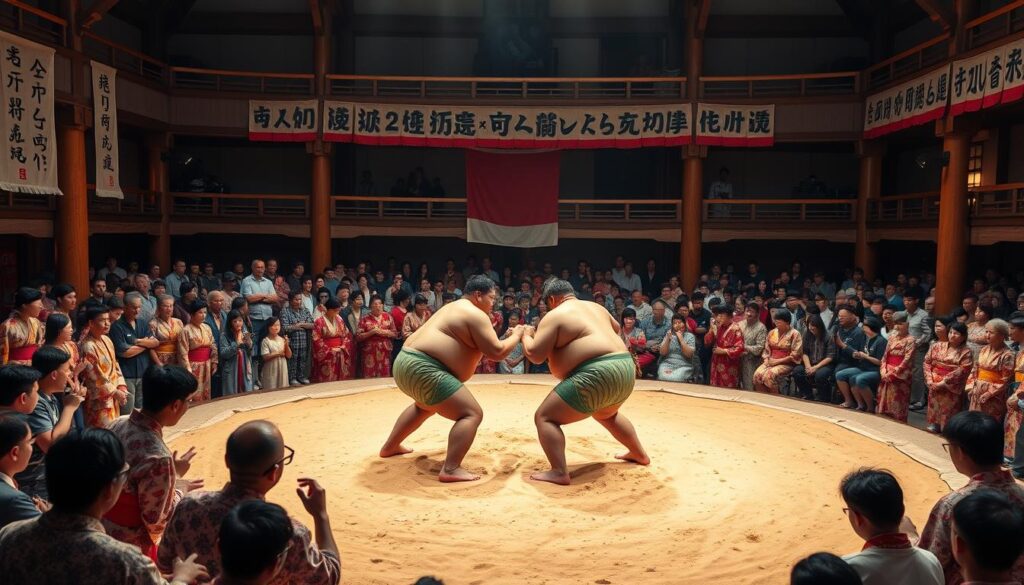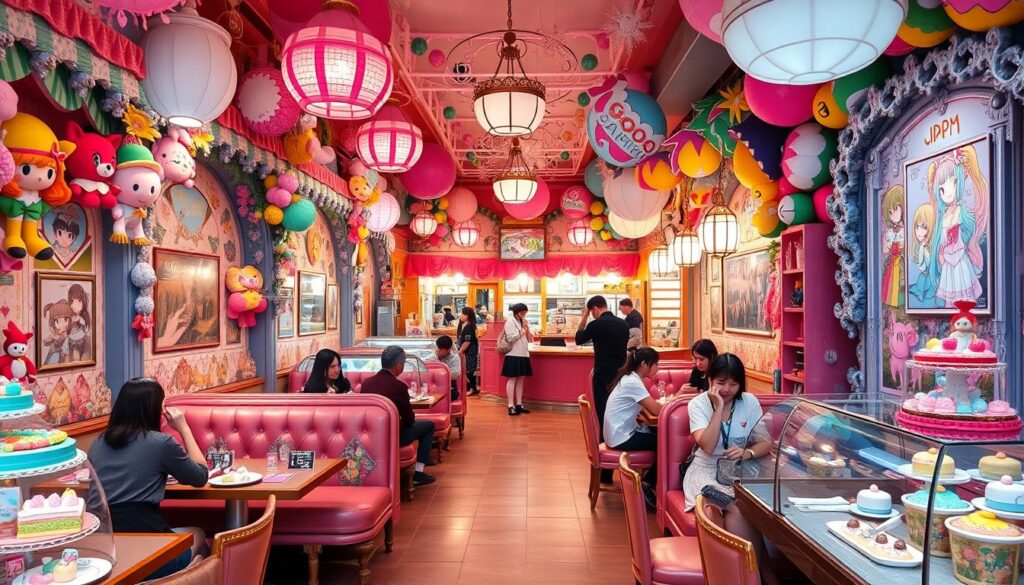Physical Address
304 North Cardinal St.
Dorchester Center, MA 02124
Physical Address
304 North Cardinal St.
Dorchester Center, MA 02124

Start an amazing journey that mixes old and new Japan. Our tips help you dive into Japan through sumo wrestling, tea ceremonies, and onsen baths. Each one lets you see Japan’s traditions and daily life up close.
Explore the charm of Geisha and Himeji Castle’s stunning beauty. This guide covers historical sites, tech marvels, and food adventures in Japan. Learn about sumo wrestling, the art of tea ceremonies, and majestic Japanese castles. Discover ten special ways to experience the best of Japan.
Experiencing the world of geishas is a unique Japanese adventure. These artists excel in classical music, dance, and Japanese traditions. The geisha culture is a vital part of Japan’s heritage. It thrills visitors with its beauty and historical layers.
Geishas have a history that goes back to the Edo period. That’s when the first women entertainers appeared. Starting their training around 15 or 16, geishas spend about five years perfecting their crafts. They learn classical Japanese arts, like playing the shamisen.
Kyoto is the hub of geisha culture, home to five main districts including Gion Koubu and Pontocho. Yet, Tokyo also has renowned geisha areas, like Shinbashi and Akasaka.
A geisha dinner is a truly special Japanese tradition. These dinners let you see a historically rich world. Guests savor kaiseki cuisine and enjoy geisha’s musical performances and dances. Tokyo’s Genyadana Hamadaya, for instance, pairs a kaiseki meal with a tea ceremony and geisha entertainment.
In Kyoto, you can join an “Evening with Geisha” in Arashiyama. This includes a kaiseki meal and mesmerizing geisha shows. Whether you’re in Tokyo, Kyoto, Kanazawa, or Fukuoka, a geisha dinner offers a deep dive into Japanese authenticity. It showcases the dedication these artists have to their craft.
The traditional Japanese tea ceremony is a deep cultural practice, not just making and drinking tea. It is rooted in Japanese traditions and Zen Buddhism. It teaches mindfulness, respect, and the beauty of simplicity. This gives travelers a true feel of Japan’s rich history and spirituality.

The tea ceremony started in the 9th century in China and reached Japan later. Sen no Rikyu, in the 16th century, shaped it into a spiritual event. Originally, it helped Buddhist monks stay awake during long meditations. Over time, it became more about elegance, simplicity, and respect for nature.
The ceremony focuses on values like purity and humility. It’s a window to Japan’s cultural beliefs and brings people closer. Visitors in cities like Tokyo can enjoy these ceremonies. They often include Zen teachings, kimono dressing, and tastings of sushi or sake.
Tea ceremonies happen in a room with tatami mats. Every detail, from utensils to decor, has a special meaning. These elements create a calm space for meditation. The host makes matcha, a special green tea, for guests. Everyone moves in a way that shows Zen Buddhism’s spirit.
These ceremonies are simple yet deeply spiritual. They’re a peaceful break from daily life. In tea rooms across Japan, guests can also learn to make wagashi and prepare matcha. This lets them dive deep into Japanese culture.
Looking for a true Japanese experience? Traditional tea ceremonies are a key to understanding Japan’s spiritual side. They’re a must-visit on any cultural trip to Japan.
The beauty and detail of Japanese castles are breathtaking. They show the rich history of Japan’s feudal times. These castles are key for anyone visiting Japan, capturing the interest of history lovers and architecture fans alike.
Japanese castles are remarkable not only for their beauty but also for their rich history. They were mainly built in the Sengoku and Edo periods. These structures are notable for their defensive features and are important historical sites.
About 95% of Japan’s castles were lost in the Meiji Period due to changes in society. Nonetheless, the surviving castles, like the “12 Original Castles,” still connect us to Japan’s feudal era.

Himeji Castle is a must-see, four hours from Tokyo. As Japan’s first UNESCO World Heritage Castle, it’s a prime example of Japanese heritage. Nicknamed the White Heron Castle, it’s famous for its grandeur and is a favorite among visitors.
Osaka Castle stands in a vast park with more than 3,000 cherry trees. Matsumoto Castle, a National Treasure completed in 1594, is known for its summer festivals.
Kumamoto Castle is among Japan’s most prized castles. It features an underground tunnel, offering a peek into historical strategies and defenses.
Visit Hirosaki Castle for a remarkable cherry blossom view, hosting one of Japan’s largest festivals. Nagoya Castle is famed for its golden dolphins, signifying the strength of its lord.
Each castle offers a unique glimpse into Japanese traditions. They are essential visits on any deep dive into Japan’s culture for tourists.
Sumo wrestling is more than just a sport in Japan; it’s a treasured tradition. It combines physical strength with spiritual practices. This sport has a history of over 1,500 years. It lets us see the rich culture of Japan. Watching a sumo match is a special way to understand Japan’s traditional sports.

Sumo matches follow strict rules and rituals. A wrestler, known as a rikishi, must push their foe out of the ring. Or, they must make them touch the ground with anything but their feet. Throwing salt before a match is a ritual for purification. These traditions show the Shinto beliefs in sumo wrestling. If you love sports or culture, learning about these rituals makes watching sumo more exciting.
To see sumo wrestling in person, plan your trip during a professional tournament. There are six major tournaments each year. They take place in cities like Tokyo, Osaka, Nagoya, and Fukuoka. Tokyo’s Ryogoku Kokugikan stadium is a key spot to watch these events. There, you can feel the power of the matches and hear the crowd’s cheers. Make sure to buy tickets early to catch this key part of Japanese sports.
For anyone interested in sports and culture, sumo wrestling is a must-see in Japan. It highlights Japan’s national pride and heritage. These tournaments offer a close look at Japan’s unique traditions. They are a must for your trip plans.
Want an unforgettable cultural event in Japan? Try a Kabuki theatre. It’s a UNESCO-recognized art that tells stories with drama, costumes, and makeup. It’s a deep dive into Japan’s artistic traditions that you must not miss.
At a Kabuki show, you’ll see amazing dance, music, and stories. Even if you don’t know Japanese, theatres like Tokyo’s Kabuki-za offer translations. This mix of old and new keeps the art form alive and exciting.
In Japan, you’ll find famous Kabuki theatres like Tokyo’s Kabuki-za. It’s known for its stunning architecture and shows. Kyoto’s Minami-za, one of the oldest, lets you see the Edo period’s splendor. Osaka’s Shin-Kabuki-za is also great, with traditional and modern plays. Visiting these theatres is an essential Japanese experience.
Japan is famous for its themed cafes. Each one offers unique experiences that amaze both locals and tourists. These places range from whimsical to spooky, showing the diversity of Japanese culture. They are a must-see for anyone exploring Japan’s hidden gems.
Themed cafes in Japan often celebrate anime and maid cultures. The first maid cafe started in 2001, creating a cute, interactive space. Maidreamin’ is a well-known cafe. It serves colorful dishes and performances, showing off modern pop culture.
At anime cafes like the Pokémon Cafe, you’ll find Pokémon-themed foods. The Kawaii Monster Cafe amazes with colorful waiters and candy-themed decor.
For those who like a thrill, The Lockup offers a dungeon theme. Alcatraz ER and Yurei Izakaya in Musashino City offer horror-filled environments. These places have creepy decor, costumes, and foods, perfect for horror fans.

Exploring these cafes’ themes, we must think about ethics, especially with animal cafes. Owl Village and Fukuro no Mise in Kyoto offer interactions with owls. Visitors should make sure these animals are treated well.
Neco Republic combines dining with helping cats find homes, offering a guilt-free experience. Neko Cafe Time in Kyoto and 39 cat cafes in Tokyo allow guests to support animal welfare. This setting is relaxing for animal lovers.
Other unique places include Zauo Shinjuku, where you catch your dinner, and Soineya Cuddle Cafe for cuddle time. The Restaurant of Mistaken Orders is run by individuals with dementia, offering a special experience.
Themed cafes in Japan provide unforgettable experiences. They range from fantasy worlds to spooky settings. Visiting them allows travelers to dive into Japanese culture, while promoting ethical dining.
Modern Japan is famous for leading in robotics and technology. The Unicorn Gundam statue in Odaiba is a prime example. It draws anime fans and tech lovers alike. These attractions mix the world of stories and advanced tech in exciting ways.

In Japan, the push for top-notch robotics is obvious. Take the Unicorn Gundam, which is about 65 feet tall and weighs 49 tons. Since its reveal in 2017, it changes form daily and offers special shows at night. These feature impressive light shows and clips from the Gundam Unicorn series.
SoftBank’s Pepper robot is another example of Japan’s robotics. It’s known for being interactive and costs around ¥198,000. The Miraikan Museum is also noteworthy. It costs ¥620 to enter and explores the future of tech through fun displays.
The Unicorn Gundam in Odaiba is a must-see. Nearby, THE GUNDAM BASE TOKYO and its ANNEX sell all kinds of Gundam items.
The Robot Restaurant in Shinjuku closed but was slated to reopen in May 2023. Instead, the Samurai Restaurant in Tokyo offers a mix of tradition and tech with shows throughout the day. It started in October 2023.
Visit Tokyo’s Narita and Haneda Airports to see service robots like Asimo. The Henn-na Hotel in Chiba uses 140 robots to provide a unique stay for around $100. It shows robots’ role in everyday services.
The big Unicorn Gundam and service robots like those in hotels show Japan’s tech wonders. These experiences are thrilling for visitors from across the globe.
Traveling through Japan at amazing speeds is possible with the iconic Shinkansen. This high-speed rail network is not just fast. It also offers an unforgettable Shinkansen experience. These trains have sleek designs and are always on time. They are a sign of how Japan masters high-speed travel. Visitors should definitely try it.
The Shinkansen started in 1964. It changed high-speed travel in Japan forever. It launched the same year as the Tokyo Olympics. This was the beginning of rapid technological progress. The rail system grew, connecting big cities like Tokyo and Osaka. Trains now reach speeds up to 320 km/h. The Shinkansen is a sign of Japan’s skill in engineering.
Many Shinkansen routes run across Japan. They offer fast and scenic travels for visitors. The Tokaido Shinkansen connects Tokyo, Kyoto, and Osaka. The Tohoku Shinkansen goes from Tokyo to Aomori. Here are some tips for a great Shinkansen ride:
Follow these tips for a smooth and enjoyable Shinkansen trip. This lets you fully enjoy Japan’s high-speed rail marvel.
Japanese cuisine is famous for its careful preparation and beautiful presentation. Visitors have a wide range of dining experiences to choose from. You can enjoy everything from street food to meals in Michelin-starred restaurants.
Street food is a key part of Japan’s culinary scene. In markets like Kyoto’s Nishiki Market, you’ll find delicious snacks. Look out for takoyaki (octopus balls), yakitori (grilled chicken skewers), and taiyaki (fish-shaped cake).
For those who want to dive deeper, cooking classes in Kyoto and Osaka are perfect. You can learn to make traditional dishes. This includes rolling sushi in Tokyo or making gluten-free soba noodles in Nagano.
Japan boasts some of the world’s top dining spots. Its Michelin-starred restaurants offer an unmatched dining experience. Tokyo alone has over 212 Michelin-starred places, including famous ones like Sukiyabashi Jiro and Narisawa.
Don’t miss the unique meals at high-end restaurants. Try the Tiger Pufferfish Specialty Store or enjoy fresh blowfish at Kanikousen. You can also savor beef tongue shabu-shabu at Kamogawa or a softshell turtle hot pot. Suzunari offers crab and Yamagata beef dishes.
A ramen tasting tour in Tokyo is a must-do. It lets you taste different ramen bowls, including those from award-winning shops. Whether attending a bento cooking class or a Wagyu beef class, fine dining in Japan is an unforgettable experience.
Onsen experiences in Japan combine relaxation with cultural insights. Set in beautiful landscapes, these hot springs are rich in minerals. People believe these waters have health benefits. Experiencing an onsen is a key part of life in Japan. It offers a break from everyday stress.
Hot springs in Japan are known for their healing powers. The mineral-rich waters help ease various health issues. For example, Kusatsu Onsen helps with skin and joint problems. Noboribetsu Onsen refreshes visitors with minerals from Hell Valley.
Traveling to Japan’s onsens is a unique adventure. Each place has its special atmosphere.
Whether you’re into the calm of traditional baths or the fun of sand and mud baths, Japan’s onsens have it all. Just remember to shower first and keep quiet in communal baths. This helps everyone have a good and respectful time.
Japan is a treasure trove of cultural immersion in Japan. Each opportunity is unique, inviting travelers into its deep cultural roots. In Kyoto, unveil the elegance of the Geisha, symbols of Japanese cultural traditions captivating onlookers for centuries. Attending a Geisha dinner lets you enjoy their artful performances up close.
Engage in a authentic Japanese experience by taking part in a traditional tea ceremony, found in major cities. These ceremonies showcase the historical grace and etiquette of Japan. For food lovers, there are sushi-making classes, especially near lively fish markets.
Sumo wrestling, key to Japanese cultural traditions, gives a powerful yet respectful show. Six major tournaments happen yearly, keeping sumo’s spirit vibrant. Besides, Ikebana, the Japanese flower arranging art, wows with its simple beauty and ties to Shintoism.
Visiting onsen towns offers more cultural immersion in Japan. Wear a kimono and relax in natural hot springs, enjoying both indoor and outdoor baths. For a deeper historical feel, stay in a ryokan. These traditional inns provide multi-course meals and rooms with futons on tatami mats, ensuring an authentic Japanese experience.
Experience the heritage of Taiko war drums. Once part of court performances and battles, they’re now a highlight at cultural festivals. Note the dates for the Gion Matsuri in Kyoto each July or the Sapporo Snow Festival in February for magical snow sculptures.
Finally, don’t overlook majestic castles like Himeji, and the peaceful Buddhist temples and Shinto shrines. With over 100 temples at Mount Koya and landmarks like Itsukushima Shrine, exploring Japanese history and spirituality is both profound and rewarding.
Japan is full of sacred sites like calm Buddhist temples and splendid Shinto shrines. These places are both cultural and spiritual hubs, showing the deep religious roots of Japan. In cities like Tokyo and Kyoto, you’ll find many temples and shrines that let you peek into Spiritual Japan.
Shintoism is Japan’s main religion, focusing on kami or spirits worship at shrines. Shinto shrines have torii gates, purification fountains, and items like old rocks or trees. On the other hand, about 40% of Japanese follow Buddhism, leading to many Buddhist temples. These temples feature Buddha statues and Zen gardens for worship and reflection. For example, Enryakuji Temple by Kyoto is a key Buddhist spot tied to the Tendai sect.
Visiting Japan means seeing some iconic temples and shrines. Kyoto, with its 1,600 sites, is a must-visit. Kiyomizu-dera, known for its views and healing waterfall, is dedicated to Kannon, the mercy goddess.
Then there’s Fushimi Inari Taisha in Kyoto with its red torii gates. In Tokyo, Meiji Shrine honors Emperor Meiji and Empress Shoken in Yoyogi Park’s forest. It’s popular for weddings. Sensoji Temple, Tokyo’s oldest, attracts millions yearly.
In Hiroshima, the Itsukushima Shrine seems to float at high tide, a magical view. Kamakura’s Hida-Sannogu shrine is key in the Sanno Matsuri, a major festival. For more unique spots, check out these secret travel spots.
Japan’s temples and shrines aren’t just for tourists; they symbolize its spiritual history. They offer a peaceful space to admire Japan’s spiritual and architectural greatness. They’re an essential part of exploring this fascinating country.
The cherry blossom season in Japan is an amazing sight. Delicate pink flowers cover the country. This beauty stands for new beginnings and shows how life is short. During this time, people enjoy hanami festivals, which are all about enjoying the view of flowers.
Mount Yoshino in Nara Prefecture is famous for hanami. It has more than 30,000 cherry trees. Tokyo’s Shinjuku Gyoen has a thousand cherry trees, including early and late bloomers. This lets people enjoy flowers for a longer time. Himeji Castle and the Philosopher’s Path in Kyoto also offer beautiful spring views.
Kenrokuen Garden in Kanazawa and Hirosaki Castle park in Aomori mix nature and culture. Hirosaki becomes a pink paradise with 2,500 cherry trees in late April. Places like Mount Fuji have cherry blossoms with amazing sceneries. Hakone and the Fuji Five Lakes region are great spots for this.
Hakodate City in Hokkaido hosts the Goryokaku Cherry Blossom Festival with 1,500 trees. The Tsuruoka Festival in Yamagata has 720 trees. Each festival has a special touch. The Kitakami Tenshochi Festival boasts a 2-kilometer tunnel of trees. For an enchanted night, visit Takato Castle Ruins Park in Nagano. The evening lights make the blossoms even prettier. Wherever you go, the cherry blossom season in Japan is unforgettable and full of culture.